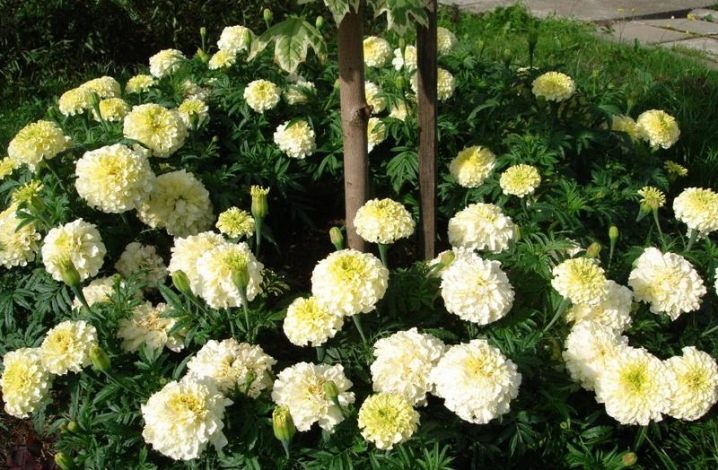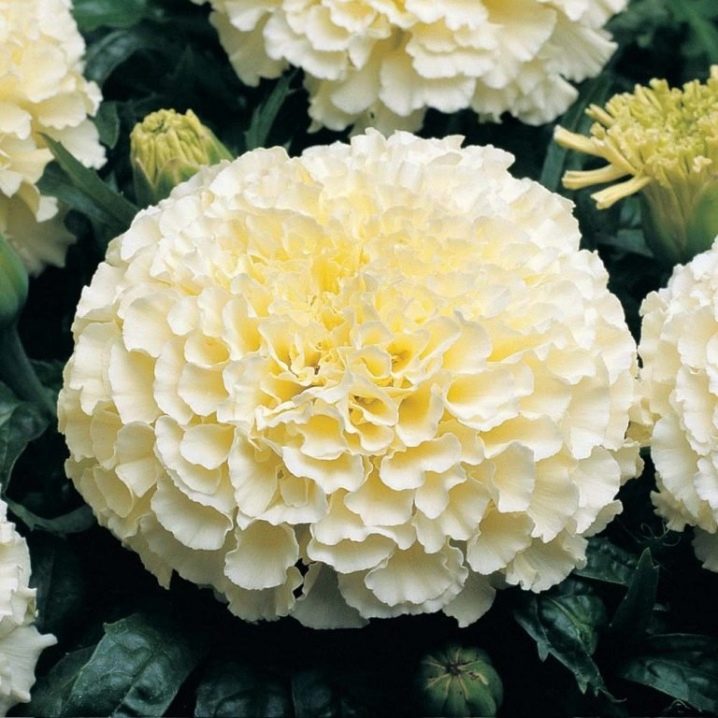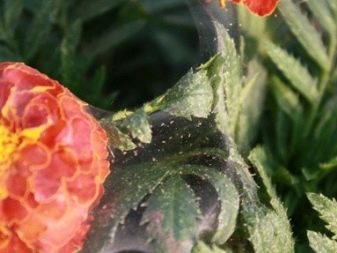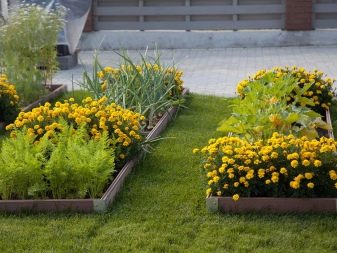Erect marigolds: varieties, rules of cultivation and reproduction

Progress does not stand still, breeders annually develop new varieties and improve existing plant species. These include erect marigolds. These luxurious tagetes have a refined structure and their voluminous color adorns the alleys and gardens.
Description
Erect marigolds can be cultivated as annual and perennial plantings, it all depends on the growing environment. The shoots of the plant are erect, which subsequently affects the structure of adult marigolds. Erect marigolds have the following features:
- shoots of a herbaceous plant are quite massive and strong, they form small lush bushes;
- the height of adult plantings depends on the type of plant; on average, the height of the bushes can vary from 15 to 125 centimeters;
- in some erect species, the leaves form a pinnately-divided form, while in others - pinnately dissected; they are colored green, but each species has an individual tone;
- the rhizome of the plant is fibrous;
- Tagetes flowers have a bowl-shaped shape, which is distinguished by a high level of strength;
- the color range of the petals is quite diverse, with the most common shades being brown, golden, yellow;
- the structure of the bud is rather unusual - the petals, which are located in the middle of the bowl, have a tubular shape, its edges are decorated with full-fledged petals;
- the shape of the petals also depends on the variety and type - in one case, they can be double, and in the other, simple;
- marigolds have a long flowering period, it begins with the onset of the summer season and lasts until the onset of cold weather;
- after the end of the flowering period, tagetes begins to bear fruit; small oblong seeds are located inside the fruit;
- such plants are distinguished by a high level of similarity, that is, the probability that seedlings are formed from all seeds is very high.
Marigold leaves have a peculiar smell, which is particularly persistent. Thanks to this feature, the plant is less susceptible to pest attacks.


Varieties
Tagetes have a huge variety of varieties, which have their own individual characteristics. They are usually classified by size, color palette and shape. We present to your attention the most popular varieties of marigolds.
- "Eskimo"... The bushes are quite compact in size and belong to the undersized representatives of marigolds. They reach a maximum of 35 centimeters in height. The flower bowl combines spherical terry petals and at the same time their tubular position. A distinctive feature is the white color of the petals.

- Discovery. Such marigolds are undersized orange plants. They have a long flowering period. The height of the plantations does not exceed 25 centimeters. The buds can be up to 6 centimeters in diameter. Inflorescences have many colors. The plant is ideal for growing in our country, it is unpretentious in care and perfectly tolerates bad weather.

- Taishan. The height of an adult plant does not exceed 30 centimeters. The flowering period begins in mid-May and lasts until September. Flowers have a large tubular shape, their diameter can be 0.8 centimeters.The buds are usually colored golden yellow.

- Vanilla F1. The plant is classified as medium-sized, it can reach a height of half a meter. The width of the bush is 30 centimeters. The maximum diameter of small inflorescences is 8 centimeters. The petals are cream colored and the middle of the calyx is yellow.

- "Hawaii". This variety is a representative of upright giants. The flowers of the plant have a clove-colored appearance, and their diameter can reach 14 centimeters. They are colored in an orange shade, they are distinguished by massive and strong shoots.

- "Albatross". This representative of marigolds is an annual shrub, the height of which varies from 40 to 50 centimeters. The buds are white and spherical. The diameter of the flower bowl reaches 10 centimeters.

- "Snow White". Plantings can be up to 45 centimeters in height. The flowers are cream-colored and reach 15 centimeters in diameter. Compared to other plants, it has a lower similarity rate.

- "Disco Mix". These are stunted marigolds, their height does not exceed 25 centimeters. The diameter of the flower bowl is 6 centimeters. The petals are painted in yellow and velvet shades. The flowering period is from spring to autumn.

Planting and care in the open field
With the onset of warmth, you can start planting marigolds. The most suitable month is May. You can sow seeds for seedlings with the onset of spring in a container, and after the emergence of seedlings, plant them in open ground. Planting Tagetes includes the following steps:
- a special mixture should be prepared for the soil - components such as peat, humus and sand are suitable for this, and you can also use mineral fertilizers;
- it is better to choose an area with an abundant amount of light, a light shadow is only welcome;
- digging small holes for planting; it is necessary to deepen the seedling no more than 2 cm;
- the distance depends on the size of the shrubs, it can vary from 20 to 40 centimeters;
- the bottom is covered with drainage to prevent stagnation of water at the rhizome;
- then you can plant seedlings;
- It is recommended to intensively moisturize the plants for several weeks.


Novice flower growers prefer tagetes because of their unpretentious care. The procedure is fairly standard and consists of several stages.
- Watering. The plantings need to be moistened regularly, but in moderation. When a plant is in a vegetative state, it requires abundant watering. With the onset of the flowering period, watering is reduced again. In the summer season, the best time for watering is the evening time of the day.
- Loosening the soil. This process is imperative so that the root system can be saturated with oxygen. It is also necessary to get rid of weedy grass around the shrub from time to time.
- Top dressing. This is not a mandatory criterion in the cultivation of marigolds, but it will not be superfluous. Top dressing promotes more lush and abundant flowering. Any organic fertilizer is suitable for this type. Manure is an exception, it is strongly discouraged to use it. The first feeding is done at a time when the marigolds begin to grow. The second time is when small buds appear on the shoots. The third feeding is done immediately before the appearance of the inflorescences.
- Pruning. Pruning is done for decorative purposes. It is recommended to carry out this process during the summer season. Buds that have withered should be cut to achieve stronger flowering.


Disease and pest control
Due to the specific smell of the leaves, marigolds are less susceptible to diseases that are carried by various pests. And also Tagetes can protect not only themselves, but also neighboring plantations. Usually, pests can infect the plant if not properly cared for. Let's take a look at some of them.
- Gray rot. Usually, this disease occurs due to the improper moisturizing regime of the marigolds. At the initial stages, a plant can be cured of such a disease with the help of a soap solution and treatment with special preparations. But with a complete infection, there is practically no chance of recovery. The plant just starts to die. So that nearby growing plantations do not undergo the same disease, it is necessary to get rid of the plant and burn it.

- Spider mite. An increased level of humidity is a huge risk zone for the appearance of a tick on a plant. The main thing is to detect the disease in time. In specialized stores, you can purchase the necessary preparation for the treatment of flowers. If you are an adherent of traditional methods of combating the disease, then you can prepare the solution yourself. A mixture of onions and millennials is considered popular.


- Slugs and snails. As in the previous case, pests appear in rainy weather. The main thing is to notice them right away in order to prevent infection, in which case they can simply be removed by hand. The best treatment for disease is to prevent it by taking preventive measures. It is recommended to place any suitable container filled with bleach near the flowers.

Reproduction
You can breed tagetes yourself. There are two ways to propagate this type of plant: sowing seeds in open ground and sowing seedlings.
Sowing seeds in open ground
This method is practiced in the southern regions of Russia, since the soil has already warmed up enough, and the probability of frost is zero. The best time for sowing is early May. The planting process is as follows:
- first, you should properly prepare the soil;
- after that, you can sow the seeds, but usually they also undergo some preparation - three days before planting, the seeds are placed in a small container, covered with a damp cloth and wrapped in plastic material, the container should be placed in a warm place, and after the procedure is completed, the seeds are ready for sowing;
- the holes should not be too deep (up to 5 centimeters);
- for normal development, you need to keep a distance between the pits;
- after sowing, the holes covered with earth must be watered with a small amount of water;
- when seedlings sprout from the seeds, the site should be thinned out, leaving only strong seedlings.


Planting seedlings
The seeds are sown in the first month of spring. In this case, already in the middle of summer you will get full-fledged bushes with abundant color. The process of planting seedlings is as follows:
- for planting, it is recommended to prepare a special mixture saturated with nutrients; peat and sand are perfect, and turf soil can be used as an additional component;
- drainage is laid out in a small layer at the bottom of the container; small pebbles are well suited for this purpose;
- prepared soil is poured over the drainage;
- make small holes for seeds;
- for the best effect, the seeds are treated with potassium permanganate;
- deepen the seeds by no more than 3 cm; the optimal distance between sowing is 2 cm;
- after which the seedlings are sprinkled with a small amount of earth;
- then the seeds need moderate watering;
- put in a warm and well-lit place, the first shoots should appear in about three days;
- be sure to ventilate and moisturize the seedlings regularly;
- three leaves on seedlings signal a transplant into open ground;
- seedlings are usually planted in late spring.


Beautiful examples in landscape design
Erect marigolds are the favorites of landscape designers. They will become the pearl of your site. Their advantage lies in their excellent adaptability in all climatic zones. And also they are completely picky about care and have a huge number of useful properties.


Low-growing plantings can be placed at the very edge of the flower garden or along garden paths.Tall marigolds will look great in the very center of the garden bed.
If there is a vegetable garden on your site, then in such cases, gardeners recommend planting tagetes around its edges. In this case, vegetable and fruit plantations will be under reliable protection from various parasites that can lead to their diseases.


As for dwarf shrubs, they are ideal for planting in small pots. In the warm season, they can be used to decorate balconies or take them out onto the veranda. You can also make a beautiful garden composition in the form of some figure from marigolds. Erect marigold varieties are an excellent decoration for your home and garden; with proper care, these plants will quickly thank you for their luxurious appearance and wonderful floral scent.



You can get acquainted with some of the secrets of growing marigolds for seedlings in the following video.







































































































The comment was sent successfully.